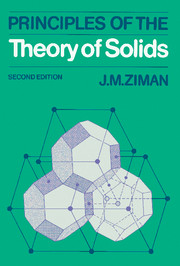Book contents
- Frontmatter
- PREFACE
- PREFACE TO THE SECOND EDITION
- Contents
- Chapter 1 Periodic Structures
- Chapter 2 Lattice Waves
- Chapter 3 Electron States
- Chapter 4 Static Properties of Solids
- Chapter 5 Electron-Electron Interaction
- Chapter 6 Dynamics of Electrons
- Chapter 7 Transport Properties
- Chapter 8 Optical Properties
- Chapter 9 The Fermi Surface
- Chapter 10 Magnetism
- Chapter 11 Superconductivity
- Bibliography
- Index
Chapter 3 - Electron States
Published online by Cambridge University Press: 05 June 2013
- Frontmatter
- PREFACE
- PREFACE TO THE SECOND EDITION
- Contents
- Chapter 1 Periodic Structures
- Chapter 2 Lattice Waves
- Chapter 3 Electron States
- Chapter 4 Static Properties of Solids
- Chapter 5 Electron-Electron Interaction
- Chapter 6 Dynamics of Electrons
- Chapter 7 Transport Properties
- Chapter 8 Optical Properties
- Chapter 9 The Fermi Surface
- Chapter 10 Magnetism
- Chapter 11 Superconductivity
- Bibliography
- Index
Summary
There are nine and sixty ways of constructing tribal lays, And-every-single-one-of-them-is-right.
KIPLINGFree electrons
Consider solid Na. Each atom contains 11 electrons. But 10 of these are in states which are tightly bound to the nucleus to form an ion of net positive charge + |e|. In the free atom the final electron moves in an orbital around this ion. When the atoms are brought together into a solid, the orbitais overlap and interact. It is argued that the overlap is so extensive that the quantization scheme in which each electron is localized on its own atom must break down. It must be replaced by a scheme in which the wave-function of each electron is a solution of the Schrödinger equation for motion in the potential of all the ions. Thus, we distinguish at the outset between the core electrons, which are treated as almost completely localized, and the valence electrons or conduction electrons, which are assumed to go into Bloch states—states extended throughout the whole crystal.
In this chapter we shall use the one-electron model, where we ignore any interactions between the valence electrons due to their Coulomb repulsion. These effects, of correlation and exchange, are discussed in Chapter 5. Such effects in the core, or between core and valence electrons, are usually treated as part of the potential V(r) seen by each valence electron as it moves through the crystal. Thus, V(r) is supposed to be calculated as a Hartree or Hartree–Fock potential of the ion.
- Type
- Chapter
- Information
- Principles of the Theory of Solids , pp. 77 - 118Publisher: Cambridge University PressPrint publication year: 1972



